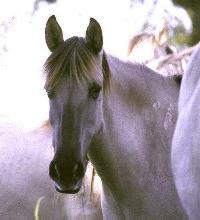Alter R�al (AR) -
Famous for breeding the bay horses used by the Portugues Riding School |
| One of
the three main lineages of Lusitanos: Andrade, Veiga and Coudelaria
Nacional, each line differing from the others by variations
in individual characteristics, but all strictly framed within
the race standard. |
| � |
The Alter-Real is a breed
of horse that
originated in Portugal.
Their name comes from the village Alter
do Ch�o. They are an Iberian breed
and are considered Baroque
horses. They are closely related to the more common Lusitano.
|
| � |
| History: The Alter
R�al was founded in 1748 by the Portuguese king D. Jo�o
V established by the House of Braganza in Villa do Portel. The purpose was to provide
horses for the Royal Stables at Lisbon that
were suitable for classical equitation, and also, good carriage
horses. After 8 years the stud was moved to Alter, a town known
for mineral rich soil and a high nutrient content in grazing.
That explains the first part of the name, as for real,
that is Portuguese for royal. The breed was started with
300 Andalusian mares,
imported from Spain, and Arabian stallions.
In the Peninsular
War (1804-14), much of the stock was spread by the French
troops; Napoleon's forces took all the best horses. In 1834,
when King Dom Miguel I de Bragan�a abdicated the throne, a lot of
the stud's land was taken, and the stud was ordered to close.
Attempts were made to revitalize the stock, with Hanoverian, Norman,
English and Arabian stock, but none were very successful, and
the Arab blood had a particularly bad influence. In the late
1800s Andalusian blood was added, and this is what finally improved
the stock. When the monarchy in Portugal ended,
the stud, and consequently the breed, would have disappeared. Ruy
d'Andrade, Portugal's greatest equestrian authority, prevented
this. He was able to save a small amount of Alter Real breeding
stock, and he line bred successfully to 2 stallions. In 1932
the stud was given over to the Portuguese Ministry of Agriculture.
Since then the breed has been improved by culling out unsuitable
mares and using only the finest stallions. There are still not
a great deal of Alter Reals, but they're not in danger, and they
are a part of Portugal's cultural heritage. |
| � |
| Characteristics: It has been said that the modern
day Alter R�als look like the original breed from the 1700s. The
breed has extravagant action and great knee flexion. Standing between
15 and 16 hh, the primary colors are bay,
brown, grey, and occasionally chestnut.
The neck is arched, muscular, short and naturally carried high.
A powerful, well placed hock contributes to action. The body is
short and croup slopes to a low-set tail. The head resembles that
of the Andalusian or Lusitano in
profile. They are intelligent and high-strung, and overall suited
for a horse used for baroque classicism. |
| � |
|
Alter do Ch�o (pron. IPA: [a?'t??
du ??~u]) is a municipality in Portugal with
a total area of 362.0 km� and
a total population of 3,666 inhabitants.
The municipality is composed of 4 parishes, and is located in
the District of Portalegre.
The present Mayor is Joviano Martins Vitorino, elected by the Social
Democratic Party. The municipal holiday is Ascension Day.
Official town website: http://www.cm-alter-chao.pt/ |
|
| Ruy
d'Andrade |

A mature Sorraia mare - a rather
narrow head
is
typical, medium - long ears and a dark "sooty" face
Photography by Hardy Oelke |
Ruy d'Andrade discovered and saved from extinction
a primitive Iberian horse which he called "Sorraia", because
he found these horses along the Portuguese river Sorraia.
D'Andrade also found evidence in his research that in Iberia, the domestication of the horse took place as early as the Mesolithikum, or Neolithikum. |
| � |
| Various sources: http://www.lusitano-interagro.com and
the net; www.Wikipedia.org |
| � |
| Lusitano Sub-Breeds: [AlterReal
(AR)] - [Andrade]
- [PSCN]
- [Veiga] |
|


